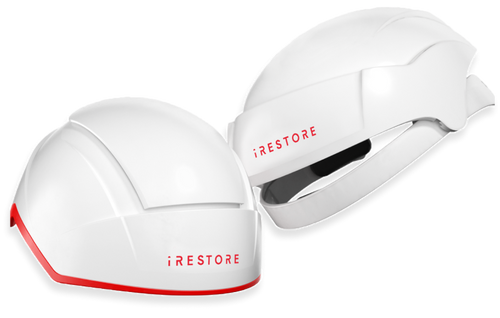Notice your hair falling out daily?
…it may not be as bad as you think.
The average person loses 50 to 100 hairs per day. That is considered “normal” and not a cause for concern. It happens when you’re taking a shower, blow-drying your hair, or even just sleeping. And while most people don’t see these few loose strands as a cause for alarm, for many others it’s a cause for concern.
Whether your hair is in the early stages of receding or already showing signs of more significant thinning, there are quite a few options available on the market to stop the progression of hair loss so you can free yourself from the stress and frustration.
But first, let’s get into the “why.”
Why Is My Hair Falling Out?
According to the American Academy of Dermatology (AAD), hair loss and thinning affect 50 million men and 30 million women in the U.S. Many conditions and diseases can result in hair loss, the AAD reports, as can improper hair care.
While the exact cause of hair loss may not be fully understood, the most common type of hair loss is due to genetics – called male pattern baldness or female pattern baldness. It usually occurs gradually and in predictable patterns — a receding hairline and bald spots in men and thinning hair in women.
Heredity also affects the age at which you begin to lose hair, the rate of hair loss, and the extent of baldness, the Mayo Clinic points out. Pattern baldness is most common in men and can begin as early as puberty. This type of hair loss may involve both hair thinning and miniaturization (hair becomes soft, fine, and short over time).
Beyond Genetics... What Else Causes Hair Loss?
Going beyond heredity and the “normal” daily shedding that we all experience, the AAD points out that people who notice their hair shedding in large amounts after combing or brushing can trace the problem back to one or more of these 12 causes:
-
- Excessive or improper use of styling products such as perms, dyes, gels, relaxers or sprays, which can cause weathering or hair breakage.
- Hairstyles that pull on the hair, like ponytails and braids.
- Shampooing, combing, or brushing hair too much or too hard, or pulling it out
- A variety of diseases, including thyroid disease.
- Childbirth, major surgery, a high fever or severe infection, stress, or even the flu.
- Inadequate protein or iron in the diet, or eating disorders such as anorexia and bulimia.
- Certain prescription drugs, including blood thinners, high-dose vitamin A, and medicines for arthritis, depression, gout, heart problems, and high blood pressure.
- Use of birth control pills (usually in women with an inherited tendency for hair thinning).
- Hormonal imbalances, especially in women.
- Ringworm of the scalp, a contagious fungal infection most common in children
- Some cancer treatments, such as radiation therapy and chemotherapy.
- Alopecia areata, a type of hair loss that affects all ages, which causes hair to fall out in round patches.
Hair Loss: What’s the Big Fuss?
The physical symptoms of hair loss can be traumatic, but the psychosocial impact of hair loss can be just as severe, according to the AAD. “Hair loss can cause dramatic and devastating emotions in patients that can negatively impact their quality of life,” the organization states.
Studies on the psychosocial impact of hair loss have found patients’ self-esteem, body image, and self-confidence to be negatively affected,” the organization reports, with depression, low self-esteem, altered self-image, and less frequent and enjoyable social engagement being some of the most impactful side effects of hair loss.
Up until recently, hair loss sufferers had just a handful of hair restoration methods at their avail, none of which have been proven universally effective. Topical creams, oral/prescription based medications, injectable cortisone or hormonal medications, hair transplantation surgery, and scalp reduction surgery were all used to help men with male pattern baldness and women with thinning hair.
Some of these methods require surgical procedures that may leave scars while others required hair loss sufferers to take drugs that could produce even more negative side effects than the hair loss itself.
So what other options do hair loss sufferers have?
LLLT – What Is It?
Thanks to advancements in technology over the last few years, there’s a new solution that men and women can turn to restore their hair from younger days without the need for pills or surgery.
Commonly known as low-level laser therapy (or LLLT), this FDA-cleared solution uses clinical-strength laser technology to treat hair loss and thinning hair for both men and women. LLLT uses non-invasive, pain-free light technology to stimulate hair follicles and scientifically induce regrowth of thicker, fuller hair.
Introducing: Low-Level Lasers for Hair Restoration
All across the U.S., hair-loss sufferers are realizing the benefits of LLLT for restoring their hair’s youthful consistency, texture, and glow. Here are four more benefits of laser hair growth therapy:
- It’s both safe and effective. The National Institutes of Health’s studies have shown that low-level laser therapy stimulated hair growth in mice subjected to chemotherapy-induced alopecia and also in alopecia areata. “After the discovery of lasers in the 1960s, there has been tremendous interest in using these laser devices to treat various medical conditions,” the NIH reports, noting that controlled clinical trials demonstrated that LLLT stimulated hair growth in both men and women. In conclusion, NIH says that LLLT for hair growth in both men and women appears to be both safe and effective.
- The medical community has been using cold laser for decades. According to the International Society of Hair Restoration Surgery, the use of lasers for medical purposes is not new. Lasers have been in use for medical purposes for many years and the physics, chemistry, and biology of laser light interaction with human tissue are well documented, the ISHRS reports. Medical uses range from surgery using high-powered lasers to stimulation of tissue repair.
- There are no scalpels, cutting, or burning. Let’s face it, no one wants to go under the knife if he or she doesn’t have to. With LLLT, the lasers used for hair growth therapy are referred to as “cold” because their light is absorbed by target tissue but does not heat the target tissue as occurs with lasers used to cut and remodel tissue. The light wavelength emitted from a low-level laser will repair tissues that have impaired cellular metabolism by stimulating blood circulation, encouraging regeneration of normal healthy tissues, and encouraging bio stimulatory effect on the hair follicle. LLLT is not a light source that causes thermal or heat damage, there is no cutting or burning sensation at all.
- It’s already been proven to increase hair density. People have been using lasers as a hair removal method for years, but up until recently the long-term impact on the individual hair follicles was unknown. Recently, the NIH found an uncommon but striking adverse effect of lasers being used for hair removal: an increase in hair density, color, or coarseness or a combination of these occurs at or around sites treated for hair removal. This bodes well for uses of low-level lasers for hair growth!
What Are You Waiting For?
There is a myriad of hair loss solutions available on the market, but few can boast a safe, effective, and side-effect free approach for users like LLLT can. In addition, many physicians believe laser therapy can be used in conjunction with other hair loss treatments to boost results, so it becomes a no-brainer to add LLLT to your hair care regimen.
“I recommend laser therapy to anyone suffering from alopecia as it’s clinically proven to reverse hair loss.” – Dr. Adam Bodian
Adam Bodian, M.D. is a board-certified laser surgeon and a member of the American Academy of Dermatology based out of New York. He conducted the latest clinical research study on the top-rated laser hair growth device on Amazon – the iRESTORE Laser Hair Growth System.
For the 80 million men and women in the U.S. who suffer from hair loss, there is hope after all. If you have not yet tried laser hair therapy for yourself, be warned – there is a small chance that it may not work for you due to people’s varying response to light therapy.
With that in mind, however, companies like Freedom Laser Therapy (that’s us, for those who aren’t aware) understand the natural skepticism and uncertainty around this type of technology. In response to this, we’ve decided to provide a 12-month 100% money back guarantee to our customers. This gives YOU the opportunity to try the device risk-free in the comfort of your own home – we know how embarrassing it can be – and gives you a peace of mind knowing that you’re guaranteed results or a full refund.
So if you’re ready to take the leap of faith, take a look at the iRESTORE to find out for yourself whether low-level light therapy can reverse your hair loss and help you look and feel younger today.















